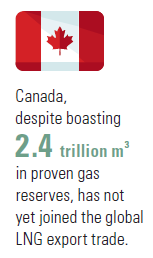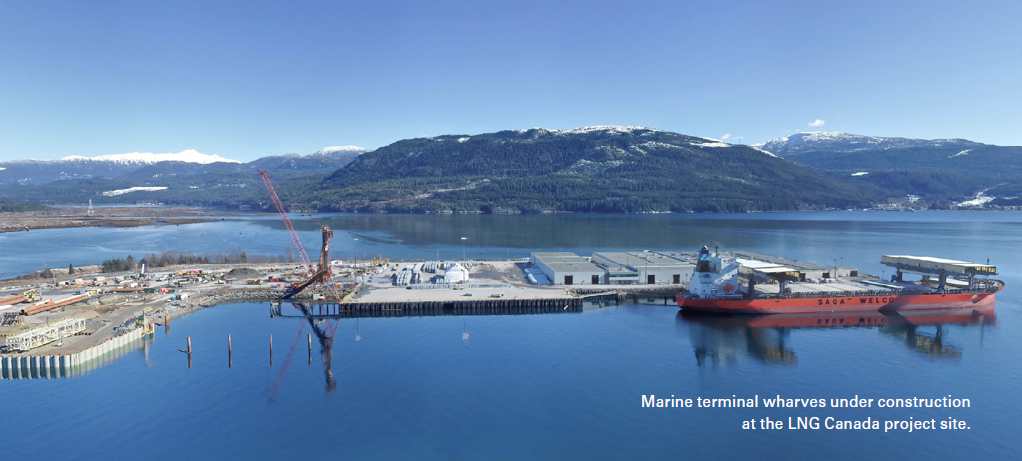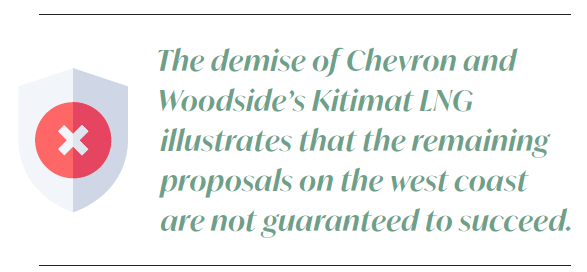Ups and downs for Canadian LNG [Gas in Transition]
There has been a mix of good news and bad news for Canada’s nascent LNG export industry recently. Construction continues on the Royal Dutch Shell-led LNG Canada project, and there are other proposals that are yet to reach the final investment decision (FID) stage, including the newly unveiled Ksi Lisims LNG project.
At the same time, though, some projects appear to be on the verge of falling through, despite not having yet been officially cancelled. On Canada’s west coast, both Chevron and Woodside Energy announced in the past few months that they would exit the Kitimat LNG project, in which each company owns a 50% stake. And in eastern Canada, two high-profile setbacks to LNG projects came recently. The government of Quebec rejected the Energie Saguenay project proposal on environmental grounds, while Pieridae Energy shelved plans for its Goldboro LNG terminal in Nova Scotia and is evaluating strategic alternatives for that project.
These developments illustrate the mixed prospects for further Canadian LNG development. Much seems to depend on project-specific factors, including location. Additionally, environmental concerns are increasingly at the forefront of considerations for any new scheme, and appear set to play a major role in influencing whether projects can move forward.
Setbacks
The setbacks experienced by certain projects came about for a variety of reasons. In the case of the Energie Saguenay project, which is being developed by privately owned GNL Quebec, the company’s efforts to demonstrate the scheme’s environmental credentials fell short of provincial government expectations.
GNL Quebec had said that the project would involve a carbon-neutral facility, fired by hydropower and offsetting its remaining direct emissions. However, Quebec environment minister Benoit Charette said in July that GNL Quebec had failed to demonstrate that Energie Saguenay would result in a net reduction in emissions.
 As a result of this and other concerns raised during the regulatory review process for the project, the Quebec government concluded that the risks of the project outweighed its benefits. It also dismissed claims that buying LNG would allow offtakers from Energie Saguenay to move away from more polluting fuels such as coal and crude oil, saying this could not be guaranteed.
As a result of this and other concerns raised during the regulatory review process for the project, the Quebec government concluded that the risks of the project outweighed its benefits. It also dismissed claims that buying LNG would allow offtakers from Energie Saguenay to move away from more polluting fuels such as coal and crude oil, saying this could not be guaranteed.
In the case of Goldboro LNG, meanwhile, it appears that Pieridae was struggling to make the economics of the project work. According to Pieridae CEO Alfred Sorensen, the company had not been able to meet all of the conditions necessary to make an FID on Goldboro by June 30, the deadline it had set for such a decision. In a July 2 statement, he cited cost pressures and time constraints related to the COVID-19 pandemic as making building the current version of the project “impractical”.
As a result, Pieridae decided to “move Goldboro LNG in a new direction”, launching a strategic review of alternatives that could still make the project work. This fits within a broader review of all of Pieridae’s assets and operations – which also includes upstream properties – with the company saying strategic alternatives may include a sale or merger.
Neither project has yet been cancelled outright, and both operators are still evaluating their next steps. However, the future of LNG exports from eastern Canada looks increasingly bleak.
Martin King, a senior analyst at consultancy RBN Energy, said he believed it to be the end of the road for eastern Canadian LNG export plans.
“A lot of those projects had a pretty limited shelf life, and they also were kind of in a bind in terms of getting a hold of gas supply to start with,” he told NGW. “It was something that was challenging at the best of times, and now we're seeing the end result of that.”
By contrast, King sees better prospects for Canada’s west coast.
“I think the big advantage all of those projects have is just their proximity to supply. They're obviously much, much closer to all the main producing basins and the main producing plays in western Canada than anything on the east coast. Even if they tapped into US gas supply, it was still a lot more challenging for those east coast players,” he said.
The west coast benefits from its relative proximity to demand as well as supply. The region offers a shorter sailing time to Asia and allows tankers to travel there without transiting the Panama Canal – both factors that King described as a “huge advantage” for west coast projects.
Indeed, bottlenecks in the Panama Canal were among the factors contributing to a spike in Asian LNG spot prices in the winter, serving to illustrate how attractive alternative routes could be.
More proposals
It is perhaps unsurprising, therefore, that various new LNG projects on the west coast are still being pursued, including the new Ksi Lisims LNG project, which was proposed in July.
The scheme was announced by a British Columbia (BC) First Nation, the Nisga'a Nation, in partnership with Rockies LNG Partners and Western LNG. The group is proposing to build a 12mn metric ton/year facility – almost the same size as the LNG Canada project.
It is not the only First Nation-backed project under development. A smaller facility, the 3mn mt/yr Cedar LNG, has also been proposed for the BC coast. In June, the Haisla Nation partnered with Pembina Pipeline to take that project forward.
Also in the works is the privately owned Woodfibre LNG project – the smallest of the west coast proposals at 2.1mn mt/yr. That project is targeting an FID in the third quarter of 2021 and recently signed a second offtake agreement with BP, bringing total supply to the major to 1.5mn mt/yr.
The future thus looks brighter for LNG development on the west coast, though King sounded a note of caution.
“It looks like there could be more [projects] coming but we've seen a long list of projects come and go for the west coast and the only one that's reached an FID is LNG Canada,” he said. “It's more optimistic, it's good to hear, but we'll see if these schemes meet economic thresholds and if they can go ahead.”
Indeed, the demise of Chevron and Woodside’s Kitimat LNG illustrates that the remaining proposals on the west coast are not guaranteed to succeed. Chevron and Woodside are both involved in other LNG projects around the world and King suggested that with the local labour force tied up in the construction of LNG Canada, other opportunities elsewhere may have looked more appealing to the two companies.
“I don't think it's necessarily a negative for Canadian LNG,” he said, but rather a case of Kitimat LNG being an increasingly low priority for Chevron and Woodside.
As demonstrated in Quebec, any operator trying to gain regulatory approvals for a new LNG export project will have to work hard to demonstrate that project’s environmental credentials. Indeed, both Cedar LNG and Ksi Lisims are talking up the steps they would take to be low-carbon options, including the use of renewable electricity.
“They're doing everything they can to lower the CO2 profile of those projects, and I think that's going to be with us permanently going forward,” said King.
As also demonstrated in Quebec, this may not be enough, but on the other hand BC has long been more supportive of LNG development. The fact that the two most recently proposed projects are being driven by First Nations could also work in their favour.



